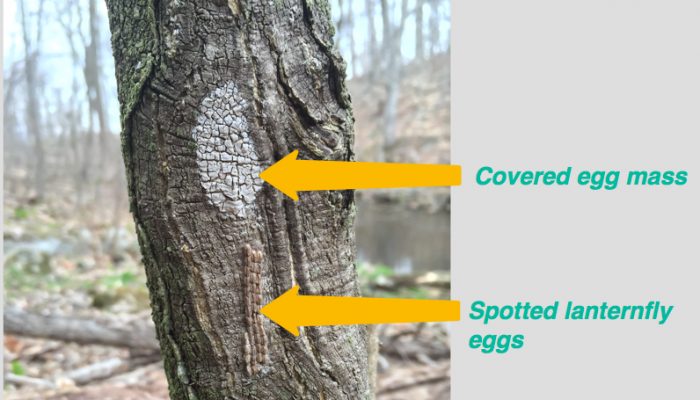You don’t have to tell Alan Cattabriga that the invasive spotted lanternfly is a real pain. The senior manager at Millikan Nursery in Chichester has been out in the rain looking for the nasty bugs’ egg masses on imported plants more times than he cares to remember.
“We spend an incredible amount of time doing this,” he said. “It’s hard to look for them when it’s raining out, when it snows out. … We’ll unload the truck, and if it’s one of those freak snowstorms, we’ll wait until the next day, but it’s got to be done.”
State entomologist Piera Siegert sent me to Millikan Nursery because she says they’re doing it right: When they buy trees, shrubs and other nursery stock from places where the lanternfly is established, they take the time to look for and remove the egg masses.
I’ve been in Philadelphia, near ground zero for the infestation of a bug that can devastate many species of plants, and I can testify that spotting those masses is not easy. I can’t believe some of them haven’t snuck through, especially since not all nurseries are so scrupulous. But I am happy to report that Siegert says: “We have found no evidence of established spotted lanternfly in New Hampshire.”
I asked her about this because a national lanternfly map showed activity in Merrimack County. She says that the marker indicated an “interception” — meaning an egg mass was spotted on imported nursery stock — rather than a presence in the wild.
Don’t get too comfortable, however. “Will we find it here at some point? Absolutely,” she predicted.
This is a common situation for invasive pests, whether bugs, animals or plants: One group of people trying to keep other people from accidentally spreading the bad thing, realizing that they will probably fail in the long run.
Most invasives in the U.S. were accidentally brought from Asia as part of international trade and have gone crazy because they lack natural predators here. The problem isn’t a one-way street: Many invasive pests in China, like the fall armyworm, were accidentally imported from here.
Many times, the effort to keep people from spreading invasives is an obvious lost cause. Volunteers and biologists have been trying for years to keep boaters from carrying Eurasian milfoil between one New Hampshire water body and another, for example, but the slimy weed keeps showing up in new locations.
Sometimes, though, it works.
I was sure the Asian long-horned beetle would be here by now after its population exploded in Worcester in 2008, but that outbreak and another in Boston in 2010 were contained or eradicated before the beetles could be brought north by accident.
Similarly, the chronic wasting disease that devastates herds of deer and related species out west showed up in New York state in 2005. It seemed likely that it would soon be brought back to New Hampshire lurking inside a trophy head to celebrate an Adirondacks hunting trip. But it hasn’t shown up here and may have been contained.
Successful containment depends on lots of work on the ground and, importantly, lots of public education. It’s hard to keep that education from sounding like a bout of grade-school scolding, which turns people off and blocks the message. But when it works, it works.
Hunters are a great example of a community that has been made aware of a problem and risen to the task of helping contain it. Boaters, not so much.
It behooves all of us to do our part, of course. Don’t carry firewood too far (it can hold an insane number of bugs that will flee when you light up), don’t chop down Japanese knotweed and toss the bits (they take root and grow), don’t release pet amphibians or reptiles into the wild when you’re tired of them and don’t plant pretty invasives like burning bush.
And if you buy a tree or bush from a nursery that hasn’t been grown locally, check it for funny-looking blobs before you plant it. You don’t want to be ground zero if — sorry, when — the spotted lanternfly arrives.


 Return to the Concord Monitor
Return to the Concord Monitor